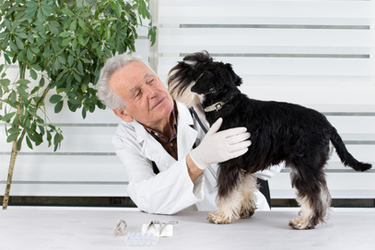Tips for Clients: How to Give Your Dog Medication

During a dog’s life, there may come a time when the owner will be the one responsible for administering the pet’s medicines. Sometimes, conveying this information to pet owners is difficult. The following tips offer suggestions on ways to provide this care in a way that is safe and frustration-free!
Client Tips for Administering Medication to Dogs
How to Give Pills, Tablets, or Capsules
Tip #1. Do not break the pill, tablet, or capsule into pieces or crush into a powder.
- Some medicines have a protective coating that delays the release of the medication. Breaking or crushing the medicine will destroy the protective coating
- Some coatings not only mask the bad taste of the medicine, but also slow the disintegration of the medicine’s surface layer to give the animal the chance to comfortably swallow.
Tip #2. Many dogs will readily consume medicines hidden in food.
To conceal the medicine:
- Using canned dog food, form several small meatballs. For example, if there are two pills to give, make five meatballs
- Two of the meatballs will each hold one pill, the other three are undoctored
- Place one pill deep into the center of one of the meatballs
- Offer the dog one undoctored meatball, then one with a pill
- Follow with an undoctored meatball, the final meatball with a pill, and then the last meatball
If you prefer not to use dog food, your veterinarian may be able to recommend commercial treats or other acceptable foods that are made specifically for hiding and holding medicines.
Tip #3. Follow these steps to administer medicine without hiding it in food:
- Slip your thumb behind a canine tooth and press up on the roof of the mouth
- As the mouth opens, press down on the lower jaw with the opposite thumb
- As you press in on both lips from above the muzzle, the dog’s mouth should open
- Place the pill to the back of the tongue, in the middle of the mouth
- If the pill is not placed far enough back on the tongue, the animal will spit it out
- Close the mouth
- Rub the dog’s throat until it swallows
- If the dog licks its nose, the pill has been swallowed
- Give the dog a small treat.
How to Give Liquid Medicine
Tip #1. When administering a medicine in liquid form:
- Medicine should be contained in a plastic syringe, eyedropper, or medicine bottle
- Placing hand under muzzle, gently squeeze to pinch lips together
- Insert the dispenser into the cheek pouch between the molars and the cheek
- Tilt the dog’s chin up while slowly dispensing the liquid
- The dog will swallow on its own.
Tip #2. Never push a full syringe of liquid down the dog’s throat.
Tip #3. Make sure to give the animal frequent chances to swallow.
How to Give Pet Injections at Home
Most injections should be given by the veterinarian or a vet technician at the clinic. While injections are usually not painful, there are drawbacks to administering them at home, for instance:
- Possibility of an allergic or anaphylactic reaction which will require immediate veterinary care
- Difficulties in handling and restraining an uncooperative animal.
Ask the veterinarian to demonstrate.
When it is necessary to administer an injection at home, ask the veterinarian to demonstrate the procedures by pointing out:
- Withdrawal of medicine from vial, filling and reading the syringe
- Removal of air from syringe
- Attachment of needle to syringe
- Correct placement of injection, either subcutaneous or intramuscular
- How to administer injection, including:
- Sterilizing injection site
- Withdrawal of plunger to look for blood
- What you should do if blood is seen
- Needle/syringe disposal or sterilizing steps.
How to Administer Pet Suppositories
Your veterinarian may prescribe a suppository for an animal that is:
- Unable to swallow
- Vomiting
- Severely constipated.
Tip #1. Insert the suppository in this manner:
- Using petroleum jelly, lubricate the suppository
- Slide the suppository all the way into the rectum.
Tip #2. Be prepared for instantaneous results.
- When suppositories are being used to help with constipation, be ready to take the dog outside for a bowel movement.
Reassure Your Clients
Administering medicine is not difficult, but there are procedures to follow that will make it easier on both your client and their pet! They trust you to provide them with information to ensure their pet’s health. Give them the information they need to work with you to do so.
Your Covetrus representative can help to identify additional ways to provide a pet with continued home care. Contact us at 855.724.3461.
Need Regulatory Assistance
If you need help with regulatory or licensing issues, we're happy to help. We have a wide variety of resources to help you when issues arise.

Careers
Are you looking for a place to let your talents shine? At Covetrus, we help our practitioner customers better serve their patients and take pride in providing the best customer experience possible. Search our open positions to see our available opportunities.
Newsletter
Stay current with what’s going on with Covetrus, subscribe to receive our newsletter and email communications. Subscribers will receive the latest information in practice management, sales and marketing, animal health, and more.


Leave a comment